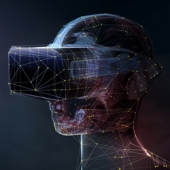Microsoft’s Charles Drayton: The metaverse will benefit from a Web 3 world
IN BRIEF
- "In my view, the metaverse itself is going to take a more practical form for organizations like Microsoft, primarily in business types of applications."
- "A lot of the genuine users, a lot of them are children. My nephew is eight years old, and a lot of children are building these very sophisticated applications, these very sophisticated games and levels on it. So I think if we’re going to see that sort of mass uptake, it probably won’t be this generation. It’ll be his generation."
- "Going forward and through expanding the umbrella of this for metaverse to the broader concept of Web 3, I’m a big fan of the idea of having digital ownership of your own data. […] Who owns your healthcare data right now? It’s not you. It should be you."
Kathie Topel, a Director with Protiviti’s Business Performance Improvement practice, sits down with Microsoft’s Charles Drayton to discuss how the metaverse will benefit from a Web 3 world, as well as when, how and even if the metaverse will deliver on its promise.
In this interview:
1:14 - Where we are in the metaverse cycle
3:38 - Microsoft's view on the metaverse
6:30 - The metaverse and generative AI
8:36 - What is the timetable for metaverse adoption?
11:48 - Metaverse use cases
13:10 - The metaverse and Web 3
14:45 - The metaverse and healthcare
19:00 - The metaverse: Game changer or a niche space?
Microsoft’s Charles Drayton: The metaverse will benefit from a Web 3 world
Joe Kornik: Welcome to the VISION by Protiviti Interview. I’m Joe Kornik, Editor-in-Chief of VISION by Protiviti, a global content resource examining big themes impacting the C-suite and executive boardrooms worldwide. Today, we’re exploring the metaverse future and I’m happy to welcome in Microsoft Charles Drayton, Digital Contact Center platform lead for the chief product office at Microsoft. Prior to joining CPO, Charles was the chief technical architect and worldwide healthcare and life sciences lead at the Microsoft Technology Center in Chicago. Charles has an extensive background in retail, manufacturing, and healthcare, and is the creator of the Intelligent Healthcare Experience, the largest showcase of healthcare technology anywhere at Microsoft.
Today, I’m happy to turn over the interviewing to my college, Kathie Topel. Kathie is a Director with Protiviti’s Business Performance Improvement practice. Kathie, I’ll turn it over to you to begin.
Kathie Topel: Thanks, Joe. Charles, the metaverse has gone through all sorts of hype cycles the last 18 months or so. Lately, it seems there’s been more negative news. Where do you see us in the cycle and has your overall perception of the metaverse’s potential impact changed?
Charles Drayton: I think first we have to think about what exactly the metaverse is and what it isn’t. Part of it is, I don’t think there is necessarily a universally agreed upon definition of the metaverse itself. I think people often think of the metaverse as VR and AR, MR, XRs all being interchangeable. That’s not really the case. I think VR can be a component of the metaverse, but the metaverse at its heart is really just any shared digital landscape, any place where people can go and interact with each other. To that end, there are actually a number of metaverses that exist already, and many of them have had a fair degree of popularity. So, I don’t necessarily think it’s failed. I don’t necessarily think it’s on the way out. I think what people often believe the metaverse to be is still yet to manifest the way that I think people want it to manifest.
In many respect, it’s very similar to cryptocurrency where I think the Utopia and the vision of cryptocurrency was that we are going to have this universal free currency that would exist for everyone and would be without borders and would allow anyone to buy anything anywhere and would just free us from the shackles of nations and in reality it just became another speculative investment vehicle. [Laughter] I think in many respects the metaverse is very, very similar in the sense that while we might have conceived of it as being this digital universe where people can come together without borders and all of that, I think in reality it’s really taken a couple of forms. Some of it is gaming, and gaming in nature. The other aspect of it is really speculative in nature as well, where you are buying digital real estate and buying and selling it. Very similar to what we’ve seen with cryptocurrency. It’s taken on a somewhat different form, and where it’s going to go, I think, remains to be seen, but I’m very interested in seeing what the next version of this is going to look like.
Topel: How would you really characterize what Microsoft’s view of the metaverse is at this point in time and has it shifted recently?
Drayton: I think we’ve always had a more pragmatic view of things when it comes to this. Sure, there is a metaverse aspect to it, and there’s still going to be a number of years before the metaverse reaches whatever its final form is going to be, but in the meantime some of the aspects that are common in the metaverse such as virtual reality, augmented reality, mixed reality, as we call it, or XR, are all things that we have areas of investment in. I think our view of it at Microsoft—and I just want to clarify, I don’t speak on behalf of Microsoft even though I work at Microsoft. This is my opinion of it, not necessarily the company’s position, so I want to make sure that I’m clear on that, but in my view, from everything that I’ve seen, everything I’ve been researching, and everything I’ve experienced that the metaverse itself is going to take a more practical form for organizations like Microsoft primarily in business types of applications.
So, rather than it being a gaming platform, which I think is primarily going to be where you see a lot of consumer use of the metaverse, we’re going to see it more for B2B-type scenarios. An example of that might be the ability to have a metaverse digital twin of some sort of commercial real estate, and then use that to plan out what actual real estate is going to look like. We’ve already seen some used cases of that with the HoloLens within the standpoint of construction, or the standpoint of manufacturing, the ability to have digital twins that would exist through a corporate metaverse, where I can see a digital replica of some of the machines that we use in real life to allow me to interact with them, sort of if I want to be able to try and diagnose a problem or operate a machine or even have a digital assembly line. Those are things that we’re seeing in real life as well.
Even the ability to use the metaverse to repair things. We have an application called field service. There is a component of field service that makes use of guides, which is a mixed reality application where you can create a digital twin of an application to walk you through installing it or repairing it, or using remote assist, which is another application where we can pull someone in and both people would be able to use mixed reality markups to try and resolve a problem even though they might not both be in the same room. Those are some of the used cases that we see being the future of the metaverse. I think we have more practical value outside of just consumer use cased.
Topel: What do you really think happened? Did we move from metaverse moment to a generative AI moment?
Drayton: Generative AI moment, yes. [Laughter] It’s funny. When we first talked about this idea of talking about the metaverse I thought, “Hmm, we haven’t talked about the metaverse in a while.” That’s because a lot of what we’ve been talking about recently has been generative AI, ChatGPT, and all the variations of that. This is where a lot of our investments, a lot of our mindshare is. What the future of generative AI is going to look like, despite the fact that it’s actually younger, is a lot more assured because of the level of uptake that it’s had. So, because of that, we’ve been making a lot of investments into generative AI as a place where people are getting a lot of value very, very quickly from it.
The metaverse itself is largely speculative in nature still, and it still feels a lot like people are hunting for just the right used case, whereas anybody can use generative AI to be able to compose an email or be able to create a spreadsheet just by describing in natural language what it looks like. Like who wouldn’t want to do something like this? I do not remember how to build a pivot table. I couldn’t if you paid me. So, the ability to then go to a generative AI model and say, “Hey, build this spreadsheet that’ll give me insights into all of this data,” and have it do it for you with no expertise on your part, who doesn’t want that?
So, that’s where a lot of what we’re looking at now is going to encompass a lot of our future investment. So, how that relates back to the metaverse, I think, is an interesting question. That probably remains to be seen. I think right now a lot of where we’re looking in making investment is going to be generative AI. That being said, there is a relationship between the two, and that is in the sense of both of them are kind of foundational models of what we think of as Web 3.
Topel: Other experts have said widespread adoption will probably take longer, maybe even much longer that we originally thought. They say mobile took basically 15 years to get to where are today. Do you think that sort of timetable, say 10 to 15 years, for widespread Web 3 and metaverse adoption makes sense?
Drayton: What I find is that the best consumer technology catches fire quickly. A lot of the slow-burn technologies that people often talk about never really materialized the way that people expect it. So, think all the way back to 1999 and the Segway, right? People, when the Segway first came out, there was a whole thing about, “Oh, it’s going to change the way people transport themselves. It’s going to be the end of cars as we know it.” It didn’t really work out that way. If you ever see Segways ever it’s usually in the form of tours, like little city tours on a Segway or something like that or periodically someone will go viral because they fell off the Segway. I think Segway itself, if you go to their website, it’s primarily scooters now. You don’t really see the manufacturing of that traditional Segway anymore. So, despite the fact that it was touted as being a game changer, because it never really caught fire right away, it never really achieved what people thought it would.
Same thing with Google Glass as an example. Google Glass is another one where they released it and people said, “Hmm,” and then a lot of pundits said, “Well, give it some time. It will take a little while.” It never really became what it was meant to, and now we can’t really buy a Google Glass anymore. So I think the best kinds of consumer technologies are the kinds that really catch fire right away. In contrast, ChatGPT. Cool. Immediate, right? So, it immediately became popular. It immediately became a game changer, and now everyone is using it.
Where exactly metaverse falls into that? Probably a little closer to the former than the latter when it comes to some of these use cases that we were talking about. That being said, there are a lot of people who are using metaverse platforms. So, going back to the first part of the question and that’s, what will it look like in 15 years, if you look at a lot of the power users, not the speculative users, who are doing things like making NFTs or buying digital real estate and things like that, but a lot of the genuine users, a lot of them are children. My nephew, Jackson, he is eight years old, and a lot of children are building these very sophisticated applications, these very sophisticated games and levels on it. So I think if we’re going to see that sort of mass uptake, it probably won’t be this generation. It’ll be his generation, because these are people who are going to be more digital natives to building things on a metaverse platform. So, 15 years, if it’s going to happen, seems right given some of the things that I’ve seen with a lot of younger people I work with.
Topel: Let’s start with what people are actually using the metaverse for today and how that could evolve based on those technologies?
Drayton: I’ve talked a little bit about this earlier when I mentioned that there are—there seem to be three main use cases emerging from the metaverse umbrella. One of them is gaming, one of them is going to be a lot of the digital financial speculation, and the third one is going to be more the B2B-types of use cases. So, when you look at gaming, that’s probably where you see most metaverse applications today. You see applications like Sandbox, Bloktopia, Decentraland, Roblox, and these are all applications that have hundreds of millions of users. So, it’s not nothing, and I think that’s where a lot of the forefront of metaverse development is taking place now, except it’s still far ways away from being mainstream. The use cases associated with them are far from being mainstream as well. So, I think it’s going to require some additional use cases that would then start grabbing in more of the mainstream people. Will that happen? I think it’s something that remains to be seen. That being said, we’re definitely seeing a lot of use cases within some of that gaming, some of the development, within that as well.
Now, going forward, I’m a big believer in Web 3 because a lot of Web 3 is focused on this idea of immersion, so immersive technology. So, I mentioned earlier where does generative AI fit into the whole metaverse thing? I think both the fact that they can become features of this Web 3 concept. So, in Web 3, we think about that as everything being decentralized. Everything being built on a blockchain, but then also everything being much more immersive in nature. You see rather than Web 1 and Web 2, where you adapted yourself to the technology, Web 3, one feature of it is, it adapts itself to you. It learns from you. It’s able to anticipate what you’re going to do and then be a helpful assistant.
So, in that sense, the metaverse is very much a Web 3 sort of technology. Blockchain is very much a Web 3 sort of technology, and I believe generative AI is a Web 3 technology as well, in the sense that now you’re going to see it embedded everywhere within the coming year, and the ability to really understand you and be able to provide a co-pilot for you for everything you do is going to be something that’s really the game changer, like the ability to basically automate everything that’s rote in your life, and it’ll allow you to focus on thinking about the future, thinking about what’s new. So, all of that is going to be something that can potentially be a real game changer going forward.
Topel: Obviously, there are already success stories in the metaverse and some sectors that seem poised for big changes. Let’s start with one that’s near and dear to your heart here, Charles. Healthcare.
Drayton: So, healthcare in the metaverse, or healthcare in Web 3, I think has a lot of promise. I’ll give you a couple of examples. One example for this is going to be the use of mixed reality in a lot of healthcare use cases. So, imagine this idea of having a surgeon who specializes in a specific type of procedure. This surgeon is in another country, but you can have a metaverse application where you can have him basically live from thousands of miles away being able to get a live feed into a surgery and essentially perform virtual surgery through a machine by wearing only a HoloLens. That’s one of the far further reaching examples, but we’ve already seen a lot of development to try and start bridging that gap between the virtual and the physical.
Another example that I think we’re seeing right now would be cases where you have traveling nurses and/or traveling healthcare workers. They have a HoloLens, and they connect via the HoloLens when they’re at a patient’s home or patients who have limited mobility or who are in healthcare deserts. Healthcare desert meaning you are more than at least 50 miles away from the nearest healthcare institution. There’s a fairly high percentage of the population that would fit into that definition of a healthcare desert. So, having someone come to them, connect via HoloLens to a primary care physician can essentially extend the reach of the primary care via the metaverse through mixed reality to a patient’s home.
So this way you see a patient and a traveling nurse essentially working together even though they are many miles apart at a patient’s home and then delivering healthcare or being able to get a real time feed of patient’s vitals that would then be visualized in the form of a mixed reality dashboard that then could be seen by both the nurse and the physician at the same time. That’s an example of something that we’re seeing in practice today. Going forward and through expanding the umbrella of this for metaverse to the broader concept of Web 3, I’m a big fan of the idea of having digital ownership of your own data.
For me, one of the most exciting promises of Web 3 is that communal ownership of data. Who owns your healthcare data right now? It’s not you. It should be you. As long as it’s not you, you’re always going to be at the mercy of other organizations. So, I’ve been an advocate for a long time of the idea that healthcare records should be the sole ownership of the patient and then the patient should be able to pick and choose what organizations they’re going to share it with. This way, if you need to get your health records, you don’t have to call this hospital or who did I see last year or who did I go to last year? Now, you get a copy of it.
So the idea of having that as a Web 3 application is also going to be something that’s really valuable, because it’ll make it easier at that point to say, “Okay. Here’s who I’m going to share my proprietary personal health information with and here’s who I’m going to take it away from. I’m going to have everything centralized that everything about myself and my health history is all centralized. It’s not in four or five, six different electronic health records that I all have to hunt down in all these different health organizations. It’s all mine and mine only.” That will make a lovely Web 3 application.
Those are all the things that I’m looking forward to. I know there are still discussions and a lot of debate over how it’s going to look and what this is going to look like, but when I think about the future and the most promising applications for metaverse and Web 3, those are definitely things that come to mind.
Topel: Thanks so much, Charles. You have sort of touched on this earlier, but I’ll ask it again this way. Ultimately, will the metaverse be a transformational game changer do you think or more of a niche space where some innovative things happen?
Drayton: I suppose a bit of both. There are going to be—I think that there are some niche use cases that exists today that I think are successful, but relatively small scale. A lot of the things with the HoloLens that I talked about they’re all things that exist today, but it’s not something that would be used by everyone in the US, but I also think that there’s a lot of promise for what’s to come as people start becoming more comfortable with metaverse or as the metaverse start becoming more comfortable itself. That is to say, as we start putting more of a definition on it, I think that sometimes it’s a little premature to go out and announce the metaverse to the world without really defining what it is. You ask the average person what the metaverse is, they’re going to say, “I don’t know. Something that Mark Zuckerberg does, VR or something like that.” [Laughter] So, no one can really even get it right. So, how can you sell it? How can you adopt it if no one really even knows what it is yet? So, where is it going to go? Let’s see what it becomes first and then we’ll see where it goes.
Topel: Thanks so much, Charles, for all your insights here today. I really appreciate all your thoughts and visions for the future. With that, I’ll turn it back over to you, Joe.
Kornik: Thanks, Kathie, and thank you for watching the VISION by Protiviti interview. On behalf of Kathie Topel and Microsoft’s Charles Drayton, I’m Joe Kornik and we’ll see you next time.
Kathie Topel is a director with Protiviti’s Business Performance Improvement practice and is a visionary leader with 20-plus years in business transformation, innovative strategy, organizational change management, process design and efficiency and technology solutions. She is known for advising and supporting organizations to fundamentally change the way they operate and dramatically improve their performance and results. Kathie is an expert at working with and developing cross-functional teams that can perform at exceptional levels.
Did you enjoy this content? For more like this, subscribe to the VISION by Protiviti newsletter.



































